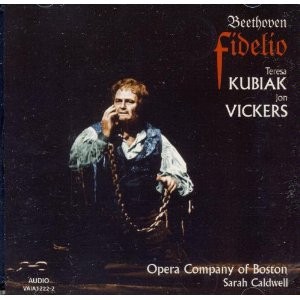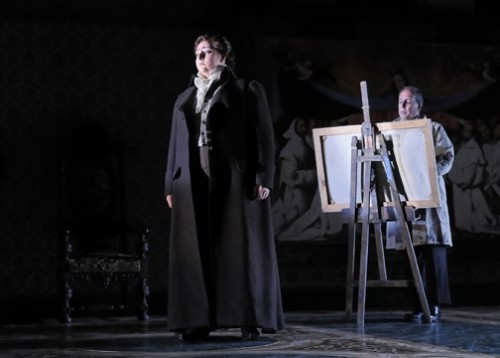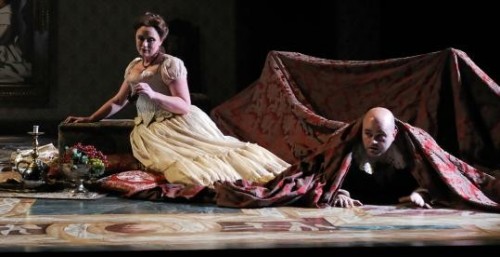Beethoven’s Fidelio by Opera Boston
Season Opens at Cutler Majestic Theatre
By: David Bonetti - Oct 23, 2010
Fidelio
By Beethoven
Opera Boston
Cutler Majestic Theatre
Additional performances: Oct. 23, 3 p.m.; Oct. 26, 7:30 p.m.
www.operaboston.org
Opera Boston’s “Fidelio” gets an A for effort but fails to graduate with honors. The fault lay not only with the directorial concept and the often ho-hum performances but with the work itself. If asked who is the greatest composer, most people would respond Beethoven without second thought. And the Beethoven who wrote the quartets, the solo piano music, and the symphonies strongly makes the case that he is. But Beethoven also wrote an opera, “Fidelio,” which is the awkward, if not quite ugly, duckling in his oeuvre. A pastiche of Singspiel, a peculiarly German form of populist music-theater with extensive spoken passages, and high-flowing romantic arias and ensembles, it never comes together, remaining two very unequal parts uneasily occupying the stage at the same time. Yet, it continues to be produced at theaters all over the world. Why? Because it contains some glorious music, tells a stirring story of rescue and liberation, and, not incidentally, is by Beethoven.
In a great production of “Fidelio,” the performers can help you overlook the discordant modes, if not entirely forget them, but that largely didn’t happen last night at the Cutler Majestic even though Opera Boston wisely decided to present the spoken text in English. (The sung text was in the original German.)
It started out promising enough. The opera is set in a jail in Enlightenment-era Spain, in which the forces of progress and reaction are in conflict. The opening scene between Marzelline, the jailer’s daughter, and Jacquino, his servant, was played and sung with verve by soprano Meredith Hansen and tenor Jason Ferrante, respectively. So when Marzelline’s charming little aria about how she likes Jacquino all right but is really in love with the Fidelio of the opera’s title, suddenly intrudes into the proceedings, it does so almost seamlessly. (Crucial plot note: Fidelio is not in fact a young man but Leonore, the wife of Florestan, a political prisoner being kept in the dungeon, who has infiltrated the prison in disguise to free her husband,) And when the great quartet of Marzelline, her father Rocco, Fidelio and Jacquino breaks through the largely comic banter, it also seems - almost – to be part of a tight compositional weave.
But that was about it. The big star of the evening, Christine Goerke, our Fidelio/Leonore, was largely inaudible in her spoken dialogue and unable to animate her scenes as the lesser characters had been. And, alas, she was not convincing as a woman dressed in men’s clothes. In general she seemed disengaged with the proceedings and her singing sounded tentative, as if she were not comfortable with the role. (She has recently sung it in Philadelphia.) Her big “aria,” in which she vents her anger at the prison governor Don Pizzaro, who has revealed his plans to kill her husband, and her resolve to free him, began promisingly, her big resonant soprano voice with a particularly rich bottom notes apparently united with text and narrative. But then she pulled back and the aria went on and on and ended without the emotional pay-off Beethoven built into it. It was not inspired singing.
After intermission, Goerke seemed to warm up and it was easier to hear her spoken text (maybe someone spoke to her during the break – it was opening night in a new house for her, after all.) But then there was the bigger problem of the extended scenes with her husband Florestan, the jailed political prisoner. Michael Hendrick just did not have the chops for the role. He teased with a stentorian tenor but his voice got wobbly and nearly broke at one point.
All things considered the best singer and performer of the evening was light, fluent bass Andrew Funk, who sang the jailer Rocco, a minor role. But because Funk commanded attention, he was able to make Rocco’s conflict between doing the right thing – helping Fidelio/Leonore free Florestan – and keeping his job and most likely his life a matter of central import. Beethoven’s intentions might not have been to shine a light on Rocco’s dilemma, but the circumstances of the evening made it that way.
And then there was Thaddeus Strassberger’s production. (The young American was responsible for the direction and set design.) There was something here to outrage or puzzle nearly everyone although overall the production was rather moderate, even timid in conception.
Strassberger favors the conservative, pretty-picture school of set design, once powerful but now being gently retired everywhere. It is hugely popular with the audience however – note Franco Zefferelli’s bloated productions at the Met - and his aim here was to please. Okay, please us then.
There were things to like about his concept. I was surprised to see that Strassberger endowed Rocco’s prison quarters with the scale and appointments of the minor aristocracy, including an entire wall of paintings by Spanish golden age painters. Productions I’ve seen show Rocco to be only one step above the prisoners he has charge of. Here his status is more like that of a Baron Scarpia – but that’s another opera. Anyway, it then made sense later that he was able to refuse the order to kill Florestan because killing was not part of his job. A man who might be thrown in the dungeon for refusing an order would be unlikely to question his superior. One with social standing might.
That wall of paintings became a liability as the evening progressed. It morphed relatively smoothly into the evil Don Pizzaro’s chambers – although it was curious that he and his jailer had the same art on the walls. But it was an awkward impediment in the scene in which the prisoners are released for a brief walk in the sun. The prison courtyard and even the dungeon itself have the same expensive salon carpet as the jailer and the prison governor. The Spanish government must have gotten a deal on that design!
I liked the sexiness of the play between Marzelline and Jacquino in the first scene. But many might object to her near rape by him. More would object to the graphic torture session that goes on in Don Pizzaro’s chambers as he tries to buy Rocco’s compliance in his plans for Florestan. That detail was certainly not in Beethoven’s scenario. I kinda liked it, though, because it showed the casual evil tyrants have practiced throughout history.
But what’s with dressing the governor Don Pizarro and the king’s minister Don Fernando in ecclesiastic drag? As far as I know, government ministers did not dress like Cardinals, even in Spain. (The former, by the way, sung by Scott Bearden, made little impression vocally. Robert Honeysucker, in the latter small, but crucial role, was serviceable.) If the goal was to blame the Church for the evils of a secular tyranny then that was conceptually a big mistake. The Church is capable of its own perfidy, but not in this opera.
My major objection was that the production tried to make the work a period piece with limited relevance to the moment. Many opera lovers object to the common practice of updating operas in order to make points the composers and librettists might never have intended. Indeed, updating can be purely gratuitous, but sometimes it illuminates a text. “Fidelio” virtually begs to be updated. Its message about freedom, both personal and political, is always timely, but, because of the creakiness of its dramatic conventions, needs to be made relevant. The first time I saw the opera was at the Met in the 1970s. The Leonore was Hildegard Behrens, who sang luminously and with real passion. The conductor was Karl Bohm. The production was traditional. I wonder if the old Nazi would have gotten on the podium to lead a production that hinted at the horrors he turned his eye away from during his rise in Vienna?
By emphasizing elements of domestic comedy and by sticking to a historical setting, the production, despite the shocking scene of torture, tended to depoliticize the work. Maybe that’s why the Prisoner’s Chorus, usually an emotional and musical high, was so tepid, and why the finale, when the prisoners are freed and the tyrant is forced to take their place – the world turned upside down - has so little juice. Beethoven is always about joy won through adversity, and there was, alas, very little joy in this production.
Gil Rose led the orchestra briskly and without romantic excess. The orchestral sound unfortunately was muffled, sounding like a vintage recording.
An Introduction/Apologia
Let me introduce myself: I have been a newspaper critic for more than 25 years. I started out in Boston at the Phoenix, and I moved to San Francisco to write for the Examiner in 1989. After the two San Francisco dailies merged in 2000, I continued at the Chronicle for a little more than a year. In 2003 I left San Francisco to work for the St. Louis Post-Dispatch. In 2009 I was laid off.
My beat has been the visual arts with occasional forays into architecture, film and literature. I have written only once about opera, a production of Richard Strauss’s “Capriccio” at the San Francisco Opera with Kiri Te Kanawa, Tatiana Troyanos and a young Simon Keenlyside. I realized then how difficult writing about opera, especially a nearly perfect production, was, and I have avoided it until asked to cover opera in Boston for Berkshire Fine Arts. Why not? I thought. Give it a try. I beg the indulgences of any reader who wants or expects a musicologist’s take on the productions I will be covering. They won’t be getting that from me.
But they will be getting the point of view of a fan. I have been an opera enthusiast ever since a college friend dragged me and two other reluctant students to hear the exotic art form. I was skeptical: Opera was a diversion for the rich. Historically it was over. In the new society soon to be born, there would be no opera - maybe opera for the people in the language they spoke. Etc. I was lucky, however: What we saw was Sarah Caldwell’s production of “La Traviata” with Joan Sutherland singing the role of the doomed courtesan. Despite my prior protestations, I was hooked.
Since then I have been a regular at the opera. In Boston, I heard everything Caldwell did, often attending all three or four performances of a production. In San Francisco I was fortunate enough to be the frequent guest at the San Francisco Opera of Examiner music critic Allan Ulrich. In St. Louis I attended many productions of the Opera Theater of St. Louis. I’ve taken frequent trips to New York to hear the Met and the NY City Opera, and wherever I’ve traveled I’ve checked out on arrival what opera was being presented. I’ve heard opera at La Scala, San Carlo, La Fenice, Rome Opera, Covent Garden, Paris Opera and the Opera Comique, Madrid Opera, Santa Fe Opera and Teatro Argentino in La Plata. I go out of my way to hear productions of Baroque opera.
I’ve heard opera at its best, and I’ve heard opera, I hope, at its worst. And mostly I’ve heard opera some place between those extremes. Still jet-lagged, I sobbed through “Norma” at the Opera Bastille. (June Anderson and Sonia Antonacci were the principals.) And, clear-headed, I wished I had brought rotten tomatoes to hurl at Carol Van Ness’s “Norma” in San Francisco. How dare she?
Opera fans know the pattern. You approach the theater with the highest expectations. Often, hopes are dashed by an imbalanced cast, a perverse directorial concept, or a general lack of focus and energy. But often, hopes are exceeded – it all comes together and you are transported by the music, story and visuals to a place none of them separately could have taken you. And that’s when you realize that all the bad or mediocre experiences notwithstanding, you can’t live without it. Opera is in your blood.






